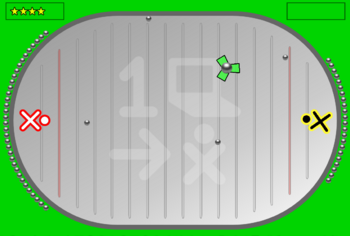User:Bjordan/GSoC 2008: Difference between revisions
| Line 18: | Line 18: | ||
[[Image:SprayPlayGameplay.png|350px|thumb|none|Spray Play playfield with computer player]] |
[[Image:SprayPlayGameplay.png|350px|thumb|none|Spray Play playfield with computer player]] |
||
== |
== Elements and Spray Play == |
||
Spray Play's speed problems will be addressed by rewriting the game using the [[Elements]] physics engine, which also allows for easy changing of drawing platforms. |
|||
<b>Elements</b> is a project that has recently implemented support for the [http://www.box2d.org Box2D] physics engine. Box2D has been used to create physics demos such as [http://www.youtube.com/watch?v=NZNTgglPbUA MIT Sketching] and games such as [http://www.youtube.com/watch?v=QsTqspnvAaI Crayon Physics]. Elements is a SWIG wrapper around Box2D, and has been shown to run well on the XO (see: [[Physic_Engines/Speed_Tests]]). The functionality of Spray Play's current physics implementation is a subset of the capabilities of Elements, and the projects would be a perfect fit. |
|||
This week, I have been discussing this project with [[User:Crazy-chris | Chris]] of the Elements project and getting acquainted with the Elements codebase. The speed benefits that will be gained from changing to the Box2D physics engine may also be bolstered by Elements' modularization of drawing code. This will allow me to change the graphics engine used if testing determines that is a significant bottleneck. |
|||
The Box2D |
|||
== Sound, [[Elements]] and SprayPlay == |
== Sound, [[Elements]] and SprayPlay == |
||
Revision as of 21:53, 30 March 2008
Spray Play and the Summer of Code 2008
I'm Brian Jordan--see my introduction to the OLPC GSoC community [1]. I created Spray Play with my brothers Greg and Eric during the Boston Game Jam during the summer of 2007. At the end of the < 3 day development period, we demoed Spray Play for a group of local schoolchildren and their parents, and their enthusiasm for the game won us the OLPC Award, which included passes to the Game Developers Conference 2008.
Abstract
Project Summary
What is Spray Play?
Spray Play is a physics-based action game based on the board game | Crossfire. Players (represented by an XO character) aim their character at the puck and spray (or shoot) projectile circles at it, attempting to move the puck into the scoring area on their opponent's side of the playing field. Shot balls stay on the playing field and slide to a collection area behind the XO characters.
Spray Play currently uses a quick-and-dirty collision detection algorithm for physics and includes sound effects bound to certain game events such as shooting (thwoop!) and ball-puck hits (clink!).
The game was originally developed during the Boston Game Jam and playtested by local schoolchildren (observed by their parents) brought in at the end of the weekend to rate games. Spray Play was rated the most fun game at the jam, and won the OLPC Award.
Spray Play has been tested on the XO, but was unfortunately found to be too slow to play reliably with enough balls to make it fun. This is due to both the algorithm used for collision detection and the efficiency of the functions used for drawing.
Screenshot
Elements and Spray Play
Spray Play's speed problems will be addressed by rewriting the game using the Elements physics engine, which also allows for easy changing of drawing platforms.
Elements is a project that has recently implemented support for the Box2D physics engine. Box2D has been used to create physics demos such as MIT Sketching and games such as Crayon Physics. Elements is a SWIG wrapper around Box2D, and has been shown to run well on the XO (see: Physic_Engines/Speed_Tests). The functionality of Spray Play's current physics implementation is a subset of the capabilities of Elements, and the projects would be a perfect fit.
This week, I have been discussing this project with Chris of the Elements project and getting acquainted with the Elements codebase. The speed benefits that will be gained from changing to the Box2D physics engine may also be bolstered by Elements' modularization of drawing code. This will allow me to change the graphics engine used if testing determines that is a significant bottleneck.
The Box2D
Sound, Elements and SprayPlay
Sound, pyGame and SprayPlay
SprayPlay as an introduction to game development (Develop)
Graphical Mock-ups
Logistical Notes
Eligibility
I am an enrolled second year student at Wesleyan University, and will be enrolled in 2008-2009 as well.
Mentoring
I have been discussing this project and the portions that would improve the Elements project with User:crazy-chris
